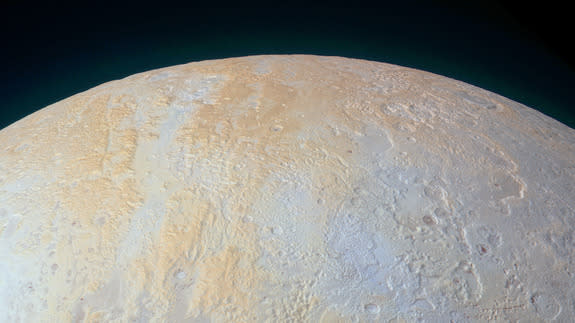Take in the beauty of Pluto's frozen north pole canyons

The icy valleys of Pluto's north pole shimmer in a new NASA photo taken by the New Horizons spacecraft.
The false color image reveals the dwarf planet's complex and craggy terrain as it appeared only 45 minutes before the probe made its closest flyby of Pluto in July 2015.
It also shows that Pluto's north pole is pretty strange looking.
SEE ALSO: Hello, Pluto: The 9-year journey to a new horizon
The dwarf planet's high elevations in the region are somewhat yellow-tinged, a coloration "not seen elsewhere on Pluto," according to NASA. Lower elevations tend to be blue-gray.
Other data collected by New Horizons has revealed that methane ice dominates the northern polar regions of the dwarf planet, without much nitrogen ice.
“One possibility is that the yellow terrains may correspond to older methane deposits that have been more processed by solar radiation than the bluer terrain,” New Horizons scientist Will Grundy said in a statement.
The largest canyon spotted in the new photo is 45 miles wide, while other parallel canyons are about 6 miles wide, NASA said.

Image: NASA/JHUAPL/SwRI
Scientists have also found other canyons on Pluto, but these north pole features may be older because they are less dramatically defined than other systems on the dwarf planet, the space agency added.
The canyons may also indicate that the dwarf planet went through some kind of period of tectonic activity in its ancient past, possibly giving researchers an understanding of how Pluto became the complicated little world it is today.
And New Horizons is still chugging along.
The spacecraft is still working to send home all of the data it collected during its close pass with Pluto. In all, it will take about one year for the probe to beam home all of its collected flyby information to Earth.
New Horizons is also making its way to a new target 1 billion miles from Pluto.
Scientists should get a look at the new world — named 2014 MU69 — in 2019, assuming NASA funds an extended mission for the spacecraft.

